
A well-planned and maintained knowledge management system is the cornerstone of a successful customer experience strategy.
No matter how great your product or service may be, customer experience can make or break your business:
- Modest improvements to customer experience can generate up to $775 million over three years for a company
- 70% of consumers say they will continue to support companies that give them great customer experience
- Poor customer experiences are costing businesses more than $75 billion a year
- 61% of consumers say they have stopped doing business with a brand due to a poor customer experience
The Temkin Group breaks customer experience down into three core elements:
Happy customers are more likely to be loyal spokespeople for your brand. ThinkJar CEO Esteban Kolsky found that 72% of consumers will tell six or more people about a good customer experience.
On the other hand, frustrated customers will most certainly go to great lengths to see your business tank – Kolsky’s study found that 13% of consumers will tell 15 or more people when they’re unhappy with a company.
So to keep your customers happy, make sure you give them a great experience. To achieve this, you must satisfy customer demand for excellent service. This is where your knowledge management system comes in – it could very well be the most important part of your corporate website.
When your customers come to you for answers, they’re most likely visiting your site, since two-thirds of them prefer to first try solving issues on their own. Your website needs to have the tools that enable them to achieve this, with your self-service portal being their first port of call.
90% of consumers expect your site to offer an online self-service support portal. 75% of consumers regard such a portal as the most convenient channel for resolving issues and getting product and service information. You need to provide them with more than a simple list of FAQs – your knowledge management system must be as intuitive as it is comprehensive.
Your knowledge management system is the backbone of your self-service portal and the key to improving customer experience.
Knowledge management can elevate customer experience
Almost three-quarters of consumers start their service queries by looking for answers online themselves. Right away, your customers are judging the experience your self-service portal delivers according to:
- the amount of time it takes them to get the information they want
- the amount of effort they need to put into their search
Your customers aren’t going to stick around for long if they can’t find what they need quickly and easily. Depending on the nature of their query, they’ll either contact your business directly through another channel or give up completely. At worst, they could end up turning to one of your competitors for better service.
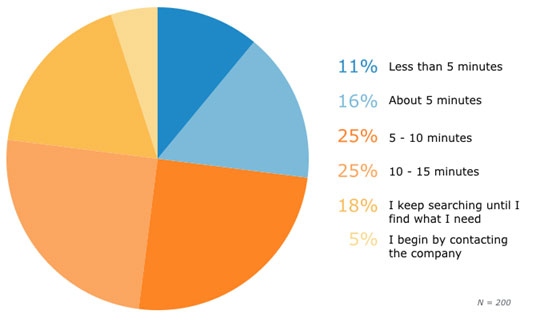
(Source)
External knowledge management benefits
A functioning knowledge management system helps your customers get information effortlessly, reducing their search duration by 80 to 20%, and showing them you value their time. Most consumers will tell you this is the most important thing you can do for them.
Your knowledge management system relieves customers of the frustration of waiting for call center representatives and tapping through endless IVR rabbit holes. You also save them the hassle of submitting help desk tickets and waiting for responses to those tickets.
Thoughtful planning also helps you build a knowledge management system that gives your customers better insights into your products and services, helping maximize the benefits they gain from your products and services. Self-service provides opportunities to deliver top-notch experiences throughout the customer journey: from research and onboarding through troubleshooting and repairs to feature optimization and referrals.
With the right planning, execution, analysis, and updating, your knowledge management strategy improves your customer experience. In turn, a better customer experience reaps several rewards, including, but not limited to:
- Greater customer loyalty and retention
- Increased word-of-mouth
- Reduced acquisition cost
- More purchases per customer
Internal knowledge management benefits
A well-executed knowledge management strategy can also benefit most of your company’s teams and internal processes. When your website’s self-service portal can handle simple support requests and repeat queries, it lightens demand on your support team. This gives team members more time to handle more complex and urgent issues that make up high-value tickets.
In this way, knowledge management empowers your customer service reps to help your development teams update features and improve your products and services. They can also give your marketing teams a better understanding of how to communicate with customers more effectively. In the long run, high-value tickets help your business provide an even better customer experience while boosting support staff engagement as important contributors to your company’s growth and success.
Your knowledge management system can also create significant cost savings. The support tickets your support teams receive through chat, email, and calls are a labor-intensive operating expense.

(Source)
Each ticket your support team handles ranges from around $3 to $50. Every time your customers resolve issues through your self-service portal, however, the cost averages $2 per ticket.
When preparing your knowledge management strategy, follow the 80/20 rule of ticket triage. Of all the tickets customer service teams handle on a daily basis, 80% of them can be handled by your self-service portal. The remaining 20% are your high-value tickets.
To help your support specialists provide fast and useful service, your knowledge management system must cover more complicated issues and provide you with actionable insights. While they may have customer service skills, team members are really only as good as the information they can access immediately.
How to use knowledge management to deliver a better customer experience
Whether you already have a knowledge management system in place, or you’re looking to create one from scratch, you want a solution that is fast, effective, affordable, and easy to build and use.
Scalability is also an important factor; as your business grows, you will need to handle increasing customer service requests efficiently without overburdening resources and blowing budgets.
Create a knowledge base that improves customer experience and benefits your organization as a whole. When doing so, it’s important to understand the difference between a knowledge base and a corporate Wiki, with the former being far more useful and advantageous than the latter.
To build out your knowledge management system effectively and efficiently, look for a solution that allows you to segment access. This eliminates the risk of overwhelming or confusing customers with too much information and helps you navigate customers to the answers they’re looking for quickly.
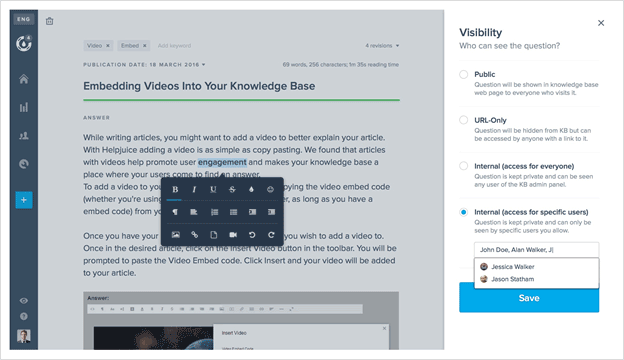
Track the usage of each segment to understand what information is most sought by customers, identify knowledge gaps, and what categories require revision, expansion, or deletion. This will give you actionable insights for continuous improvements to your
- Customer support
- Knowledge management strategy
- Knowledge management system – content, organization
- Products and services
- Company offer
- Marketing
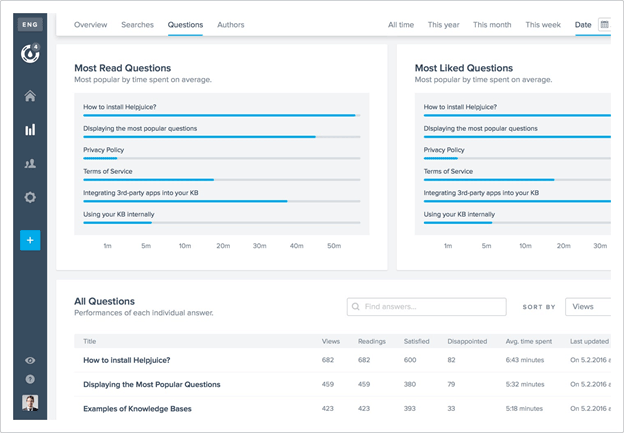
When updating each segment, be careful to avoid redundancies, and make certain all updates ultimately serve your customers.
You’ll also need to know what kind of information your customers are most likely to be searching for. They could be coming to you with queries about pricing or shipping. Maybe they’re looking for how-to guides or troubleshooting advice. You’ll most likely be relying on your support team’s experiences and insights and some market research initially. Once your knowledge management system is up and running, its analytics will be invaluable, informing you about
- Your customers’ most common questions or problems
- How your customers use your products or services
- What your customers care about
Make sure your self-service knowledge base has an intelligent search function that automatically suggests answers while customer or support staff is typing question. Account for spelling errors/typos (“Show results for…” that Google displays when user misspells search term).
Your internal knowledge management system should help customer support agents collaborate with customers in resolving customer requests as quickly as possible.
Finally, look for a solution that is intuitive enough for non-tech-savvy customers to get the information they need when they need it. At the same time, it should have features that enable different teams to leverage data that can help them achieve their department-specific KPIs.
Examples of Customer Experience Excellence Through Knowledge Management
Fullstory
The Fullstory Launchpad does a great job of centralizing information, giving new customers the guidance they need to get started with their products while also empowering their more advanced users to take their expertise to higher levels.
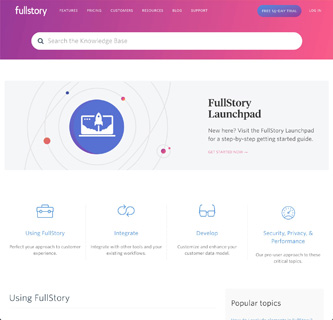
Nureva
Nureva’s thoughtful use of category icons provides customers seeking answers and assistance with an excellent user experience.
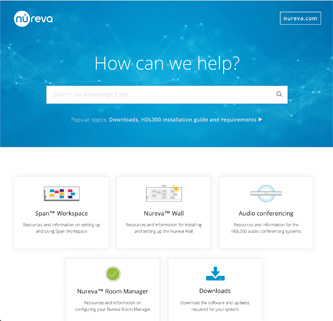
Buypeel
Just like its products, Buypeel’s online help section is sleek, minimalist, and very user-friendly.
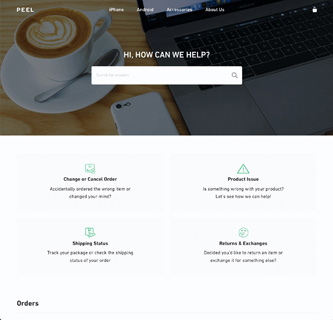
Mathseeds
Mathseeds features a kid-friendly help center that’s engaging and informative for all ages.
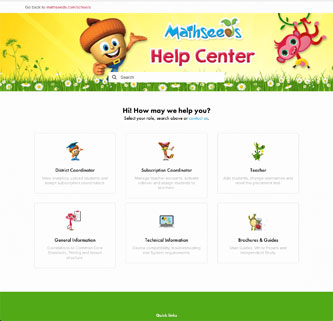
Duet Display
The mobile-first design of the Duet Display help portal is a treat to use on any device.
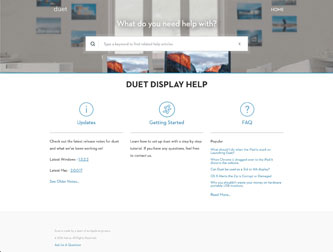
Conclusion
To paraphrase the late, great Stan Lee, with great knowledge management comes great profitability. Your customers want answers now, so there’s no better time than the present to build or update your knowledge management system.




